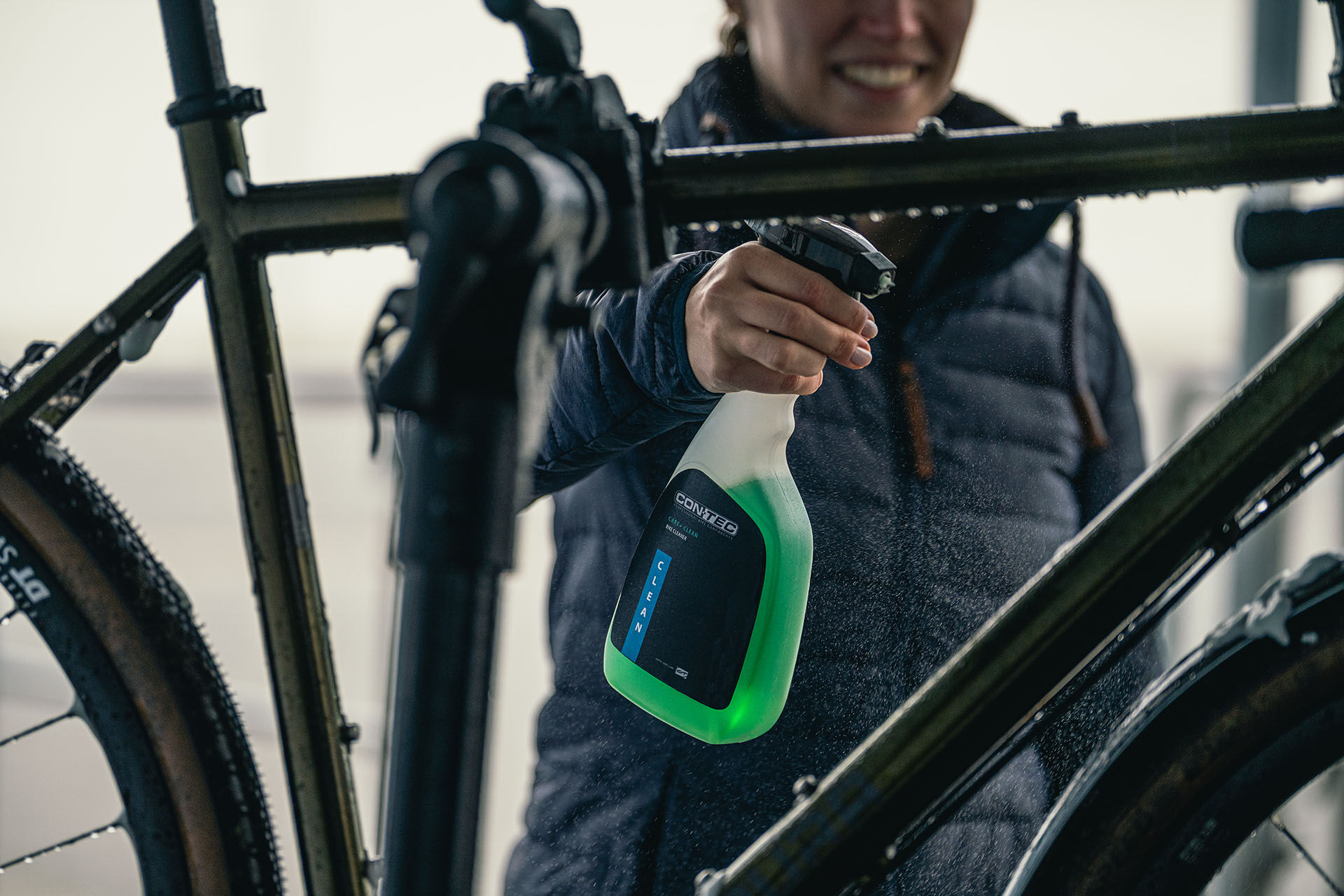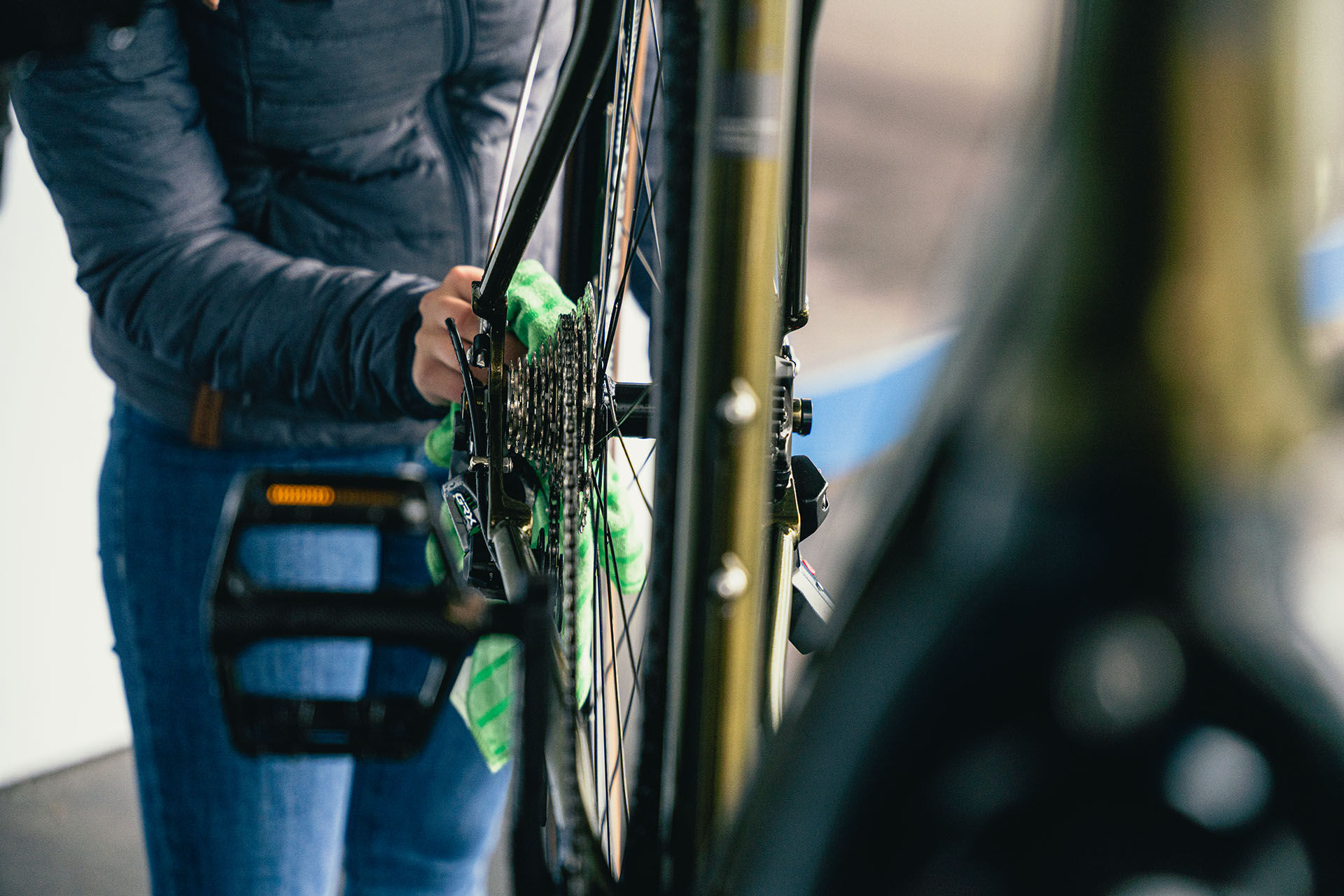Cleaning a bike

The sun is shining but your bike is full of dirt from the winter? Then it’s time for a cleaning session. Once the dirt on your bike is gone and everything is running smoothly again thanks to lubrication and grease where needed, the next rides will be a pleasure. In this How-To, we at CONTEC show you how to wash and care for your bike properly.
What is the best way to clean a bike?
Is there anything that can go wrong? Yes, unfortunately. Some people simply reach for the pressure washer, for example. But you'd better not: when quickly "washing off" your bike or in the car wash, it's easy to work with too much power. This forces water into the narrowest gaps and can cause damage in sensitive areas. You can use the pressure washer to a limited extent at a safe distance and on a low setting, but not "with high pressure". Alternatively, you can use a garden hose, also on a low setting.
You can also damage paintwork and parts with overly aggressive cleaning agents. This cannot happen to you with our Care+ Clean bike cleaner. But you can also overdose on this, thinking "more is better". A sparingly used application is usually sufficient.
Click here for the individual steps:
- Step 1 – Soaking and basic cleaning
- Step 2 – Taking care of the frame and wheels
- Step 3 – Cleaning the cassette & chain rings
- Step 4 – Cleaning the chain
- Step 5 – Rear derailleur and front derailleur
- Step 6 – Drying the whole bike
- Step 7 – Lubricating the chain
- Step 8 – The final touch with a care spray
- Step 9 – Washing your hands with hand wash paste

The right product in the right place
We recommend specific cleaning products for different areas of your bike. This has to do with the different materials and requirements of the parts.
For the chain: Particularly stubborn lubricant residues and metal abrasion collect on the chain. This requires a special degreaser, such as our Care+ Degrease degreaser.
For the wheel surface: However, the degreaser would be too aggressive on most other parts of the bike. A general dirt remover, such as the Care+ Clean bike cleaner, is sufficient here.
For care afterwards: If you need to lubricate your bike again after cleaning, you should apply a chain grease - i.e. chain oil - directly onto the chain. However, the brakes must never be oiled!
Cleaning and maintaining your bike - an overview of the materials
Let's have a look at these helpers to give your bike a new shine with great performance - a quick wash is simply not enough. Then we'll give you a step-by-step guide with valuable care tips from the CONTEC program. What you’ll need:
- Water: Either from the garden hose or in a bucket
- A sponge, preferably also a cleaning brush
- Two to three cloths or rags
- An old toothbrush or a sprocket brush
- Optionally a rim cleaner
- CONTEC Care+ Clean bike cleaner
- CONTEC Care+ Degreaser
- CONTEC Care+ Chain or Care+ Chain MTB chain oil
- CONTEC Care+ Trim Matt or Care+ Trim Shine care spray
- CONTEC Care+ Hand Wash Paste to clean your hands afterwards
If you have a bike with derailleur gears, focus on the cassette (the "sprocket set" on the rear wheel) and the chain rings (the cogs at the front of the crank). You may notice that it would also be worth giving them a thorough clean.
Either do a second round with the Care+ Clean bike cleaner and brush or you can clean the narrow gaps with an old toothbrush. A sprocket brush that is particularly narrow works best.

Degreaser or chain oil?
A special degreaser is most effective, but it should not get on the skin. Disposable gloves are recommended here. It is therefore often sufficient to use chain oil on a cloth to remove oily dirt.
In addition, the degreaser should not get into any bearings. The chain is the best place for it. You shouldn't use too much there; you don't want to soak the chain in it. There is a permanent light film of oil between the chain links, which should not be destroyed. If you overdo it with the degreasing, subsequent oiling will no longer help.
The rear derailleur, front derailleur and shifters allow you to change gears smoothly - provided they are well maintained. The two pulleys of the rear derailleur in particular tend to accumulate stubborn dirt.
A cloth with a little chain oil can help here. Thoroughly clean the front and rear sides of the derailleur pulleys. Use it to carefully clean the remaining surface of the rear and front derailleur. For hard-to-reach dirt deposits on the derailleur pulleys, you can use a screwdriver or hex key.
At this point at the latest, your bike will be grateful if you dry it quickly and thoroughly. This prevents rust from forming (especially on the chain) and allows care products to be distributed more evenly on dry surfaces. Tip: Go over the frame, fork, cockpit, and wheels with an old kitchen towel. It is best to dry the chain, sprockets, and chain rings with a separate cloth. And keep your hands off the brake discs.
Your bike is now clean and no longer wet. Time to oil the chain with a special chain oil. While you turn the crank with one hand, use the other hand to apply our Care+ Chain oil from the bottle sparingly and evenly on the chain links. Do this on the inside of the chain.
It is best to place kitchen paper underneath to prevent the oil from dripping onto the floor. In the best-case scenario, it won't do this at all, as the chain does not need to be soaked.
The chain oil must penetrate all the spaces between the chain links. A few minutes are enough before you wipe off any excess oil with a clean cloth. You can do this in the same way as when cleaning: Reach around the chain with the cloth and pull it through.
If you ride a mountain bike, we have a special chain oil for you: CONTEC Care+ Chain MTB grease adheres more strongly to the chain and keeps it reliably greased even when used in heavy rain and mud.

Applying grease to mechanical cables or not?
You will often find instructions to oil the cables that you use to operate the gears - even the brakes if they are not hydraulic brakes. We recommend not doing this. With extra oil, dust and dirt adhere more strongly to the cables and get into the inner sheaths, where everything then sticks together.
High-quality retrofit cables from CONTEC, for example, have pre-lubrication or even a low-friction coating that lasts as long as the cable. If you notice increased friction in the cables - i.e. you have to apply more force when shifting and braking - then the cable in the housing is probably already corroded.
Oiling only postpones the inevitable: Replacing the shift or brake cable. For this, we have already prepared the How-Tos replacing derailleur cables and replacing brake cables in the CONTEC guide.
If you have not yet dried your bike, you should do so now.
A care spray at the end does the paintwork some good and ensures that dust and dirt adhere less well for a while. Exposed metal is thoroughly protected against corrosion, and plastic and rubber parts as well as synthetic leather and leather are cared for. This increases the overall life of your trusty companion.
But back to the paintwork: Depending on whether the paintwork has a glossy or matt finish, we recommend the appropriate care spray: either the CONTEC Care+ Trim Matt or Care+ Trim Shine care spray.
Your bike shines and the gears purr - a fresh and clean look like on the first day! But all the dirt and oil have left their mark on your hands. With our Care+ Hand hand wash paste, your hands will be spotlessly clean again in seconds.
Simply moisten your hands and rub a small amount of the paste onto your skin - just like washing your hands with soap. The paste absorbs the oily dirt and can then simply be washed off. CONTEC hand wash paste is kind to the skin and contains natural surfactants.



Step 1 – Soaking and basic cleaning

Position your bike for washing so that you can work on it safely and it won't fall over. You can also hang it in our CONTEC Rock Steady assembly stand.
You will be most effective if you soak the dirt with water at the beginning. Simply get the whole bike wet. Either with a bucket of water and a sponge or with a garden hose. When using a hose, make sure to so at a sufficient distance and without too much pressure.



Now use the CONTEC Care+ Clean bike cleaner. You can spray it on the entire bike or just where you notice stubborn dirt. Then wait thirty seconds to one minute, that is sufficient exposure time to the cleaner.


After that, use the brush to remove the remaining dirt. Rinse with clear water and you are done with your gentle basic wash.




Step 2 - Reworking the frame and wheels


Where traces of dirt are still visible on the frame after rinsing, remove them with a sponge or cloth.
Use a sponge or cloth to remove anything that has not yet come off the wheels. Our tip: Start with the hubs, then go over the spokes (very patient people rub each spoke individually) and finish with the rims.
With disc brakes, you usually don't need to do anything else here, apart from not touching the discs with your fingers. Under no circumstances should oil or grease get on them. With rim brakes, the braking surfaces can be contaminated with brake wear. A special rim cleaning rubber can help here, which not only cleans the sides of the rims, but also ensures optimum grip for the brake pads.
Step 3 - Cleaning the cassette & chain rings



You can clean the front chain rings with a cloth on which you have applied some CONTEC degreaser Care+ Degreaser or the chain oil Care+ Chain. This helps to remove old oil, dirt, and abrasion. In some cases, you must go through tooth by tooth to get rid of all residues.
For bikes with an internal gear hub, which only have one sprocket and chain ring, it is also worth cleaning these areas, which is much easier. This also applies if you have a derailleur system with only one chainring at the front.
Step 4 – Cleaning the chain


A small brush or an old toothbrush will also help here. Use this to remove the roughest dirt from the bike chain. Now take another cloth and apply some CONTEC degreaser Care+ Degrease or chain oil Care+ Chain.
Now use the cloth to apply light pressure to the bike chain. Let the chain run through the cloth by slowly turning the crank with your other hand. While applying light pressure to the chain, remove old oil, dirt, and abrasion. After the chain has been run through the cloth several times, it should be clean enough.

Step 5 – The Rear and the derailleur

Step 6 – Dry the entire bike



Step 7 – Lubricating the chain
Step 8 – The final touches with a care spray


Step 9 – Wash your hands with a hand wash paste
Afterwards, your hard-working hands deserve a round of nourishing hand cream - which, for once, we don't have in our CONTEC range. Now we wish you a happy ride with your freshly cleaned and well-groomed bike!








